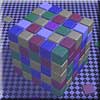|
|
|
|
|
|
|

Click here (or above) to see our online version of the cube illusion
|
|
|
In this exhibit you learn about how our brains can compensate for circumstances.
Sometimes what we see in our heads is not the same as what we see in front of us. This is because our brains are making adjustments to what we see to make up for other factors.
For example, in the Cube Illusion we see that the blue squares on the left cube and the yellow squares on the right cube are actually both grey. This is because the left cube appears to be bathed in yellow light and the right cube is under blue light. Our brains adjust for that, so we see the colours the cubes would be if that were so, not the actual colours.
This is really useful to us if we're under different colours of light. Sunlight is white, whereas indoor bulbs can often be slightly bluish or yellowish and firelight is orange. Despite this, we can still work out what colours things are under sunlight, artificial light, firelight and other coloured light.
Our vision also makes adjustments for size. Objects that are far away appear smaller. We know that this happens, but it is surprising how much difference there is. Look at a person in the distance and hold your finger up beside them: they are incredibly small.
The adjustments that our brains make often make drawing quite difficult. Art teachers will insist that you "draw what you see, not what you think you see," but it can be hard to tell the difference between the two.
The two things most people struggle with when drawing are colour or shading and scale. This is because we sometimes think two colours look different because they are different, for example white under a shade might actually be the same colour as grey under direct light. Or, we think two objects look same size because they are the same size, but one is actually much further away than the other.
This might be annoying when you're trying to draw a nice picture, but it is a survival mechanism. To keep us safe, our brains need to know what is actually there, and not what it looks like. We see things as the right size and the right colour, and make judgements based on that. So we see the squares on the left cube as blue because if it were a real cube they would be blue.
|
Questions
|
| 1 |
Our brains make ________ to what we see to make up for other factors. |
| 2 |
What two colours can indoor light be? |
| 3 |
How does the size of objects change when they are far away? |
| 4 |
When might a white object and a grey object appear the same shade? |
| 5 |
Why is it important to see things as they are? |
| 6 |
Can you think of any other times when you might be under coloured lights? |
|
Activities
|
| 1 |
Take a photograph with two of the same animal or object, one in the foreground and one far away in the background. Cut up the photograph (either a print-out or using a drawing computer program) and put the two animals or objects side-by-side. How much do they differ in size? Are you surprised. |
| 2 |
Take a photograph in dim light. Does the photograph look the same as what you can see with your eyes? This is because your eyes are compensating for the dim light, but the camera is not. This is also why a camera needs a flash when it's light enough for you to see. Some cameras have special settings for dim or bright light. Play with them to see if you can get your camera to see what you can see. |
|

